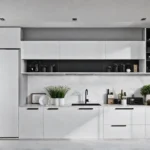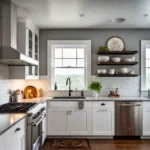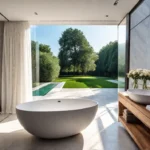Have you ever stepped into a kitchen that captivated you with its warm, inviting ambiance and seamless blend of functionality and aesthetics? The secret lies in the art of layered lighting – a symphony of ambient, task, and accent illumination that transforms an ordinary space into a culinary haven.
Maya Angelou once said, “People will forget what you said, people will forget what you did, but people will never forget how you made them feel.” And that’s precisely what layered lighting achieves – it creates an emotional connection, elevating your kitchen from a mere workspace to a cherished gathering place where memories are forged and moments are savored.
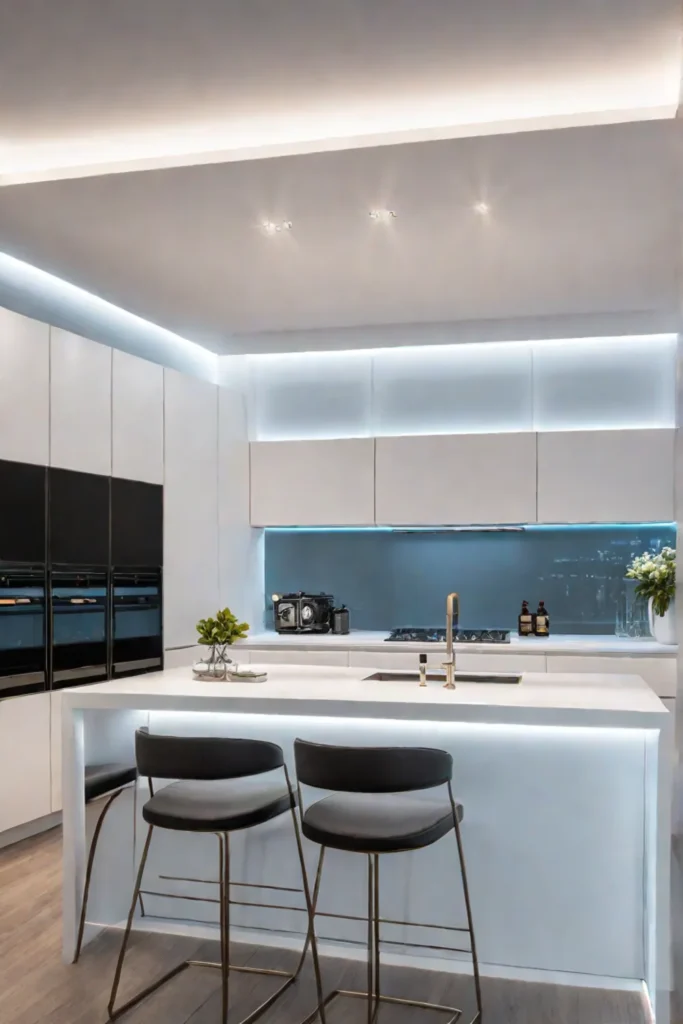
Setting the Stage: The Importance of Layered Lighting
Imagine a kitchen bathed in a single, harsh light source – it would feel stark, uninviting, and downright uninspiring. That’s where layered lighting comes into play, combining ambient, task, and accent illumination to create a harmonious, visually appealing, and highly functional space.
Ambient lighting, the foundation of your lighting scheme, sets the overall mood and ambiance. The warm, enveloping glow welcomes you into the kitchen and creates a cozy, inviting atmosphere. Task lighting, on the other hand, is the workhorse, illuminating specific areas where you prepare, cook, and clean. Finally, accent lighting adds depth and visual interest, drawing attention to architectural features, artwork, or that stunning backsplash you’ve been dying to show off.

By layering these three types of lighting, you create a multidimensional, dynamic space that looks stunning and enhances your culinary experience. Proper lighting can increase the perceived size of your kitchen by up to 25%, making it feel more spacious and inviting. And let’s not forget the practical benefits – layered lighting can improve visibility, reduce eye strain, and even boost productivity in the kitchen.
Ambient Lighting: Setting the Mood
Imagine stepping into your kitchen, and the warm, inviting glow instantly puts you at ease. That’s the power of ambient lighting – it creates a cozy, welcoming atmosphere that sets the tone for the entire space.
Recessed lights, pendant fixtures, and chandeliers are all excellent ambient lighting sources, each offering unique charm and style. Strategically positioning these fixtures throughout the kitchen ensures an even distribution of light, banishing harsh shadows and creating a sense of seamless illumination.

But it’s not just about placement – the type of light source you choose can significantly impact the ambiance. Incandescent bulbs, for instance, emit a warmer, more inviting glow than cooler LED lights. And don’t forget the magic of dimmers – adjusting the brightness of your ambient lighting can transform the mood from a lively, energetic vibe during meal prep to a soft, romantic glow for intimate dinners.
Task Lighting: Enhancing Functionality
While ambient lighting sets the stage, task lighting takes center stage, illuminating the areas where you’ll be rolling up your sleeves and getting to work. From chopping vegetables to sautéing sauces, proper task lighting ensures visibility, safety, and efficiency in the kitchen.
Undercabinet lights are a kitchen staple, casting a focused beam directly onto your countertop workspace. Pendant lights above islands or peninsulas provide ample illumination for food prep and casual dining. And let’s not forget the versatility of adjustable task lighting, like swing-arm lamps, which allow you to direct light precisely where you need it most.

But task lighting isn’t just about practicality – it’s also an opportunity to add a touch of style. Choose fixtures that complement your kitchen’s design aesthetic, whether sleek and modern or rustic and charming. And don’t be afraid to mix and match different types of task lighting for a layered, visually interesting effect.
Accent Lighting: Adding Visual Interest
Now, let’s talk about the cherry on top—accent lighting. This final layer of illumination truly brings your kitchen to life, highlighting architectural features, showcasing artwork, or accentuating that stunning backsplash you’ve been dying to show off.
Track lights, recessed fixtures, and wall sconces are all excellent choices for accent lighting, allowing you to create focal points and draw the eye to specific areas. Imagine a warm, focused beam of light highlighting the exposed beams in your vaulted ceiling or a soft glow accentuating the intricate tilework of your backsplash.

But accent lighting isn’t just about aesthetics – it can also create a warm, inviting atmosphere in cozy nooks or seating areas. A well-placed sconce or pendant light can transform a breakfast nook into a comfortable retreat for your morning coffee or evening glass of wine.
Layering Light for Maximum Impact
Now that you understand the individual roles of ambient, task, and accent lighting, it’s time to bring them together in perfect harmony. This is where the true magic of layered lighting shines (pun intended).
Imagine a kitchen where recessed lights provide a warm, enveloping glow, undercabinet fixtures illuminate the countertop workspace, and a stunning pendant light over the island serves as a focal point. Add in a few strategically placed accent lights to highlight architectural features or artwork, and you’ve created a space that is not only visually stunning but also highly functional.
But it’s not just about the fixtures – lighting controls are crucial in creating a flexible, adaptable environment. Dimmers allow you to adjust the brightness for different tasks and moods, while smart home integration puts the power of customization at your fingertips.
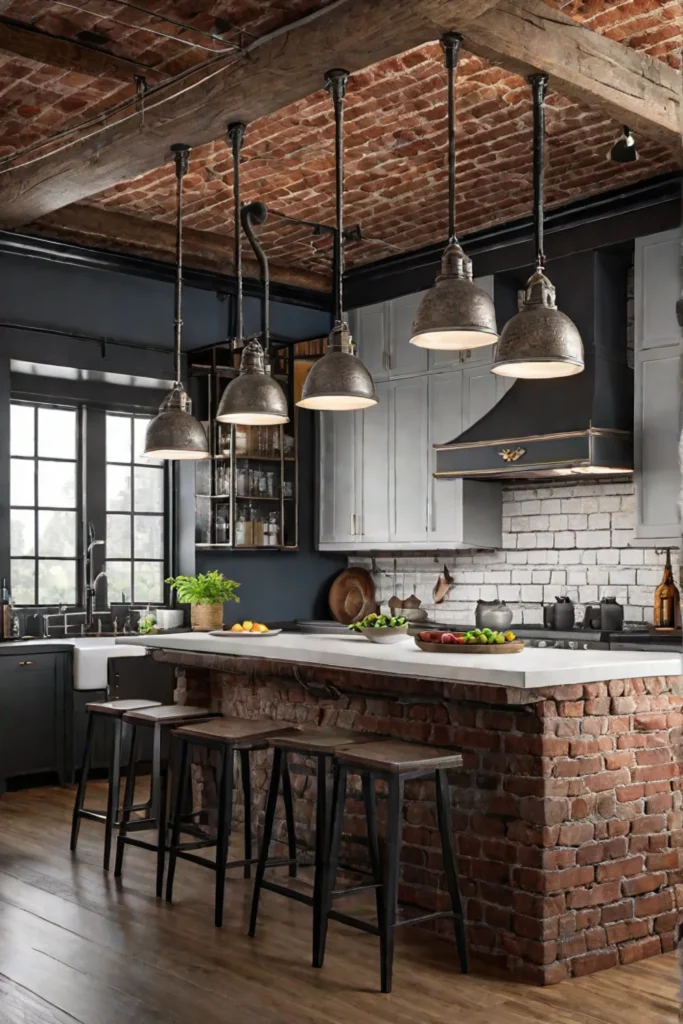
Properly layered lighting can make your kitchen appear up to 30% larger and more inviting, enhancing its perceived value and luxury. This is a true testament to the transformative power of light and its impact on our daily lives.
Lighting Placement and Positioning
Achieving the perfect lighting design isn’t just about selecting the right fixtures – it’s also about strategic placement and positioning. After all, even the most beautiful light fixtures can fall flat if installed in the optimal locations.
Regarding ambient lighting, proper spacing, and layout are key to ensuring an even, consistent light distribution throughout the space. Recessed lights, for instance, should be spaced evenly and positioned to avoid casting unwanted shadows or creating hotspots.
Task lighting, however, requires careful consideration of height and direction. Undercabinet lights should be positioned to cast a focused beam directly onto the countertop workspace. In contrast, pendant lights over islands or dining tables should be hung appropriately to provide ample illumination without causing glare or obstructing views.
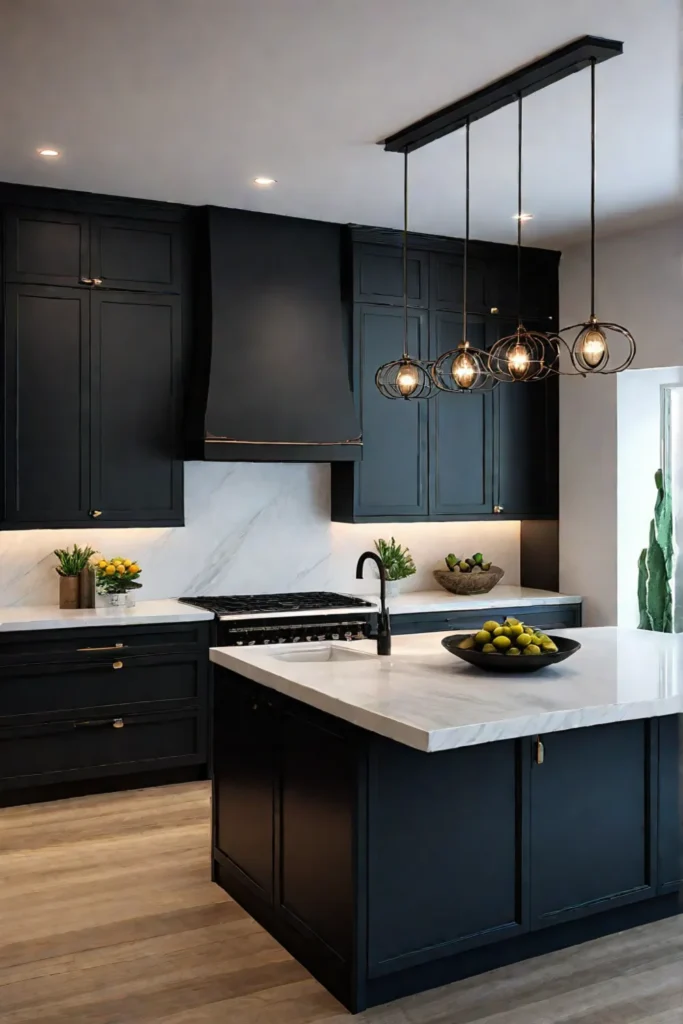
And let’s not forget about accent lighting – the strategic placement of these fixtures can make or break the overall design. A well-positioned accent light can highlight a stunning architectural feature or create a warm, inviting atmosphere in a cozy seating area.
Proper lighting placement can increase the perceived size of your kitchen by up to 15%, making it feel more spacious and inviting. Conversely, incorrect placement can lead to uneven lighting, shadows, and glare, negatively impacting the space’s functionality and aesthetics.
Lighting Controls and Flexibility
In today’s fast-paced world, flexibility is key—and this also applies to kitchen lighting. Incorporating lighting controls and smart home integration allows you to adapt your lighting scheme to suit your specific needs and preferences at any moment.

Dimmers are a game-changer, enabling you to adjust the brightness of your ambient and task lighting for different activities and times of day. Dim the lights for a cozy, intimate dinner, or crank them up for a lively gathering with friends and family.
Smart home technology takes this flexibility to the next level, allowing you to control and automate your kitchen lighting with a button or a simple voice command. Imagine walking into your kitchen and the lights automatically adjust to your preferred settings, creating the perfect ambiance for your morning routine or evening meal prep.
But lighting controls’ benefits go beyond mere convenience—they also contribute to energy efficiency and cost savings. Dimmable lighting can reduce energy consumption by up to 40%, while properly implemented lighting controls can increase the perceived value of your kitchen by up to 15%.
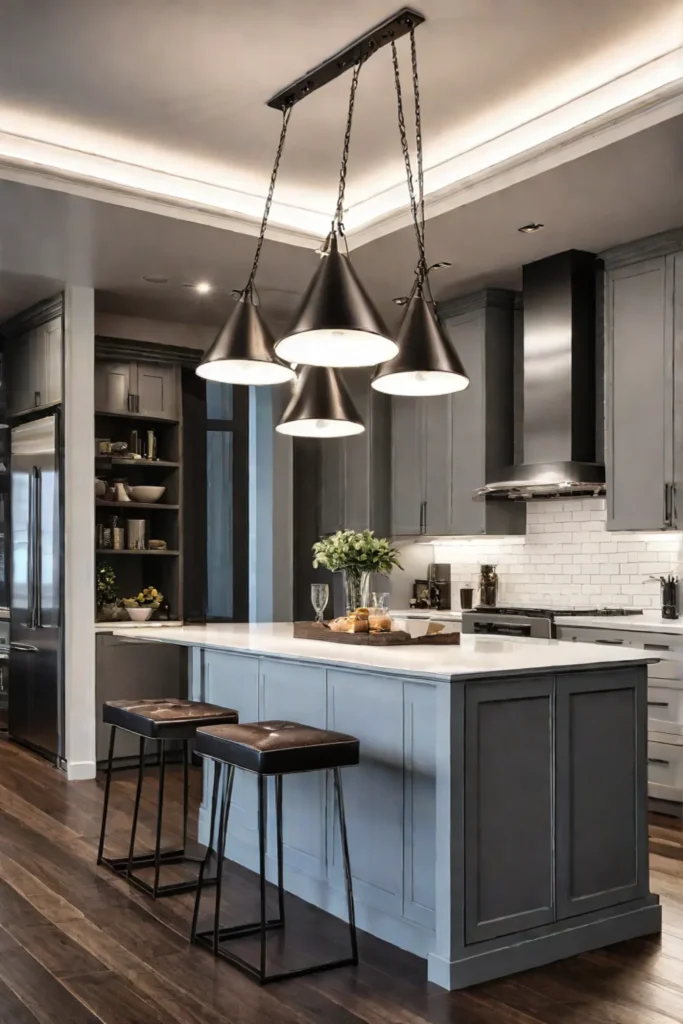
Bringing It All Together: Achieving the Perfect Kitchen Lighting Design
Now that you’ve explored the various layers of lighting and the nuances of placement, positioning, and controls, it’s time to combine everything and create the kitchen lighting design of your dreams.
Start by considering your kitchen’s overall layout, architectural features, and design style. A modern, sleek space may call for clean lines and minimalist fixtures, while a rustic, farmhouse-inspired kitchen might benefit from warm, vintage-inspired accents.
Next, strategically integrate ambient, task, and accent lighting to create a balanced design. Perhaps a combination of recessed lights, pendants, and undercabinet fixtures for ambient and task illumination, with a few well-placed track lights or sconces for accent lighting.
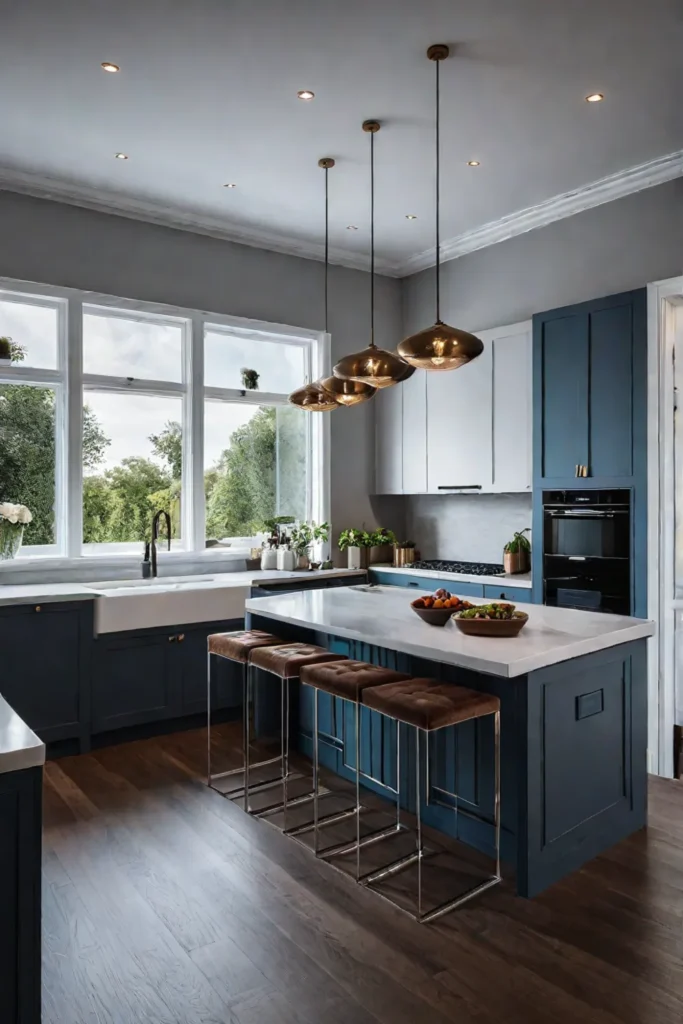
Don’t be afraid to think outside the box and get creative with your lighting scheme. Incorporate unique fixtures, play with different light sources and color temperatures, and consider how your lighting can complement and enhance the overall design aesthetic of your kitchen.
Remember, collaboration is key. Working with a lighting professional or designer can help ensure that your lighting scheme seamlessly integrates with your space’s overall aesthetic and functional requirements. They can offer expert guidance on fixture selection, placement, and controls, helping you achieve a stunning and practical design.
Conclusion
Achieving the perfect kitchen lighting design is a delicate balance of style and function, a harmonious interplay of ambient, task, and accent illumination. By understanding the power of layered lighting and embracing its transformative potential, you can create a space that looks stunning and enhances your culinary experience, making every moment spent in your kitchen a true delight.

So, embrace the magic of layered lighting and let your kitchen shine brighter than ever before. In the end, it’s not just about the fixtures or the wattage—it’s about creating a space that feels like home, a culinary haven where memories are forged and moments are savored, bathed in the perfect glow of well-crafted illumination.


